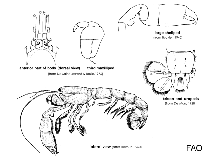Neotrypaea biffari (Holthuis, 1991)
Tidepool ghost shrimp
Upload your photos
Google image | No image available for this species;
drawing shows typical species in Callianassidae.
Google image | No image available for this species;
drawing shows typical species in Callianassidae.
Classification / Names Common names | Synonyms | CoL | ITIS | WoRMS
Malacostraca | Decapoda | Callianassidae
Environment: milieu / climate zone / depth range / distribution range Ecology
Benthic. Subtropical; 33°N - 29°N, 119°W - 114°W (Ref. 4)
Distribution Countries | FAO areas | Ecosystems | Occurrences | Introductions
Eastern Central Pacific: USA to Mexico.
Length at first maturity / Size / Weight / Age
Maturity: Lm ? range ? - ? cmCommon length : 6.0 cm BL male/unsexed; (Ref. 4)
Short description Morphology
The rostrum is a low blunt angle in the median part of the anterior margin of the carapace, being overreached by the eyes with practically their full length. The eyes are triangular with a blunt top. The antennal angles are low, rounded, without tooth. Antennular peduncle only slightly longer than antennal peduncle. Third maxilliped with ischium and merus strongly widened to form a kind of operculum; the distal three segments much narrower, each about twice as long as wide. Large chela in adult male with a small concavity above the base of the fixed finger. Carpus slightly shorter than palm, about as high as long. Lower margin of merus with a broad forward directed hook-shaped process, which ends in a triangular top. Telson about as long as wide, gradually narrowing posteriorly: the convex lateral margins merge evenly with the posterior margin. Each posterolateral angle bears two very small denticles, no median denticle present. Endopod of uropod broadly oval, slightly longer than telson (Ref. 4).
It has a total body length of 2.5 to 6 cm (Ref. 4).
Life cycle and mating behavior Maturity | Reproduction | Spawning | Eggs | Fecundity | Larvae
Members of the order Decapoda are mostly gonochoric. Mating behavior: Precopulatory courtship ritual is common (through olfactory and tactile cues); usually indirect sperm transfer.
Main reference
References | Coordinator | Collaborators
Holthuis, L.B. 1991. (Ref. 4)
IUCN Red List Status (Ref. 130435: Version 2024-1)
CITES status (Ref. 108899)
Not Evaluated
CMS (Ref. 116361)
Not Evaluated
Threat to humans
Human uses
Bait: usually
| FishSource |
Tools
More information
Trophic Ecology
Food items
Diet
Food consumption
Ration
Predators
Diet
Food consumption
Ration
Predators
Ecology
Population dynamics
Growth
Age/Size
Length-weight
Length-length
Length-frequencies
Mass conversion
Recruitment
Abundance
Age/Size
Length-weight
Length-length
Length-frequencies
Mass conversion
Recruitment
Abundance
Life cycle
Distribution
Human Related
Aquaculture profile
Stamps, Coins Misc.
Stamps, Coins Misc.
Outreach
References
Internet sources
BHL | BOLD Systems | CISTI | DiscoverLife | FAO(Publication : search) | Fishipedia | GenBank (genome, nucleotide) | GloBI | Gomexsi | Google Books | Google Scholar | Google | PubMed | Tree of Life | Wikipedia (Go, Search) | Zoological Record
Estimates based on models
Price category
(Ref. 80766):
Unknown.



